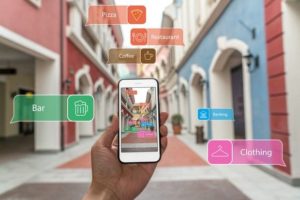
Downloaded over 750 million times, Pokemon Go was probably most people’s first experience with augmented reality (AR). The game is super easy to use and a great showcase of what’s possible with AR. The e-commerce platform company Shopify (NYSE: SHOP) is working to develop AR capabilities for its customers to allow them to compete against the likes of larger retail players. Learn about what Shopify has already accomplished with AR and virtual reality (VR) and its plans for these cutting-edge technologies.
AR raises the bar for the online retail experience
Retailers have been using AR to help sell physical goods online since as early as 2013 when IKEA released a smartphone app to allow users to “see” its furniture in their homes. Sherwin-Williams has an app that allows you to pick paint colors, add them to pictures of your home, and calculate the amount of paint needed. The home improvement retailer Lowes features an app for customers to virtually measure objects with their phones and save the measurements for later use. Not to be left out, Williams-Sonoma recently plunked down $115 million for a 3D imaging and AR platform start-up to enhance its customers’ online shopping experience.
There’s been a recent explosion in use of AR due to Apple’s ARKit, which was released to developers in June 2017, and AR capabilities built into the iOS 11 release. Tim Cook, Apple’s CEO, said in its earnings call earlier this month that, “We’ve seen great excitement around augmented reality, customers now enjoying over 2,000 ARKit-enabled apps spanning every category of apps in the App Store.”
Shopify is getting into the game, too
Shopify has been using ARKit to build AR into its e-commerce platform. The company partnered with one of its customers, Magnolia Market, owned by Chip and Joanna Gaines of HGTV’s Fixer Upper, to integrate the ARKit’s capability into its app. Customers of Magnolia Market can view the products on the app from any angle and place them virtually into their homes. For Magnolia Market, this functionality simulates the in-store experience and even allows close-up views of the small details of their products. While this isn’t breakthrough technology for customers, it is for small business owners — Shopify is building high-tech solutions for e-commerce so its customers don’t have to.
Shopify is expanding into VR as well. Daniel Beauchamp, Shopify’s head of VR, put together a VR proof of concept for the company’s Unite 2017 show for developers and partners.
You can even try out the prototype desk here. In Shopify’s blog, Beauchamp discusses the technical challenges of converting real objects into 3D models that could be used for viewing. Whether it’s combining a number of pictures together into a 3D image, hiring a computer modeler to create the model, or loading computer-aided design drawings into a converter program, all of these have drawbacks that don’t make the process easy or scalable. While this is all still pretty complex to implement, Beauchamp explains that Shopify wants to change that: “We’re always looking at new ways of pushing VR and AR technology in the world of e-commerce. Our next steps are to make it easier for merchants and partners to get started with this technology on the Shopify platform.”
While Beauchamp is dealing with the technical details of bringing these efforts to fruition, Tobi Lutke, Shopify’s CEO, has big plans for AR.
Big plans
Lutke says he is focused on reducing the learning curve for merchants to start, run, and manage their e-commerce business. The company is constantly improving its platform, but is judicious with its development efforts and focuses only on the features that most merchants will use most of the time. AR is one of those features. Not only is the company putting development resources toward AR, but Lutke also said that he wants Shopify to be the largest “AR-enabled e-commerce platform.”
Apple’s Tim Cook stopped by Shopify’s headquarters recently for demonstrations of how the company is implementing AR using ARKit. Cook came away impressed and was quite complimentary of the company and its efforts.
While it may take awhile for AR and VR to become easy enough for Shopify’s merchants to implement, this is just one more example of where the company is focused on the long term. Improving its platform to make its flywheel spin faster is something that Shopify investors and customers have come to expect.


